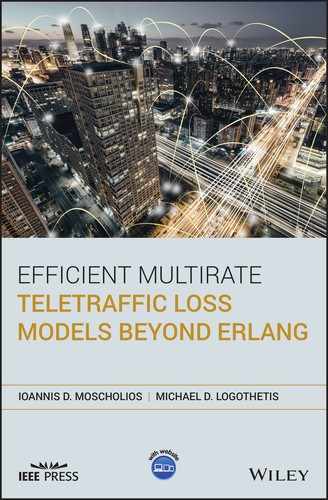Appendix A
Interdependency of the Teletraffic Models
As a summary, we present here charts of the teletraffic models covered in this book in order to show the interdependency of the models, as well as when (under what conditions, i.e., changes of their parameters) a transition from one teletraffic model to another occurs, in other words, when each model should be used.
The following parameters/symbols are included in the charts of Figures A.1, A.2, and A.3:

- The
 th + 1 contingency bandwidth requirement of service‐class
th + 1 contingency bandwidth requirement of service‐class 

- The
 th retry bandwidth of service‐class
th retry bandwidth of service‐class 

- System capacity

- Virtual capacity when the system is in state OFF

- The
 th threshold of service‐class
th threshold of service‐class 

- The
 th threshold of the system, common to all service‐classes
th threshold of the system, common to all service‐classes 
- The
 th service‐class
th service‐class 
- Number of adaptive service‐classes

- Number of elastic service‐classes

- Maximum number of in‐service calls of service‐class


- Number of in‐service calls of service‐class


- Virtual system capacity

- Trunk/bandwidth reservation parameter for service‐class


- Probability of a service‐class
 call to pass from an ON to an OFF state
call to pass from an ON to an OFF state - BP‐EA‐EMLM/BR
- Elastic adaptive Erlang multirate loss model with batched Poisson arrivals under the bandwidth reservation policy
- BP‐EA‐EMLM
- Elastic adaptive Erlang multirate loss model with batched Poisson arrivals
- BP‐E‐EMLM/BR
- Elastic Erlang multirate loss model with batched Poisson arrivals under the bandwidth reservation policy
- BP‐E‐EMLM
- Elastic Erlang multirate loss model with batched Poisson arrivals
- BP‐EMLM/BR
- Erlang multirate loss model with batched Poisson arrivals under the bandwidth reservation policy
- BP‐EMLM/TH
- Erlang multirate loss model with batched Poisson arrivals under the threshold policy
- BP‐EMLM
- Erlang multirate loss model with batched Poisson arrivals
- BR
- Bandwidth reservation
- CDTM/BR
- Connection dependent threshold model under the bandwidth reservation policy
- CDTM
- Connection dependent threshold model
- EA‐EMLM/BR
- Elastic adaptive Erlang multirate loss model under the bandwidth reservation policy
- EA‐EMLM/TH
- Elastic adaptive Erlang multirate loss model under the threshold policy
- EA‐EMLM
- Elastic adaptive Erlang multirate loss model
- EA‐EnMLM/BR
- Elastic adaptive Engset multirate loss model under the bandwidth reservation policy
- EA‐EnMLM
- Elastic adaptive Engset multirate loss model
- E‐EMLM/BR
- Elastic Erlang multirate loss model under the bandwidth reservation policy
- E‐EMLM/TH
- Elastic Erlang multirate loss model under the threshold policy
- E‐EMLM
- Elastic Erlang multirate loss model
- E‐EnMLM/BR
- Elastic Engset multirate loss model under the bandwidth reservation policy
- E‐EnMLM
- Elastic Engset multirate loss model
- EMLM/BR
- Erlang multirate loss model under the bandwidth reservation policy
- EMLM/TH
- Erlang multirate loss model under the threshold policy
- EMLM
- Erlang multirate loss model
- EnMLM/BR
- Engset multirate loss model under the bandwidth reservation policy
- EnMLM/TH
- Engset multirate loss model under the threshold policy
- EnMLM
- Engset multirate loss model
- f‐CDTM/BR
- Finite connection dependent threshold model under the bandwidth reservation policy
- f‐CDTM
- Finite connection dependent threshold model
- f‐ON‐OFF
- Finite ON–OFF multirate loss model
- ON–OFF/BR
- ON–OFF multirate loss model under the bandwidth reservation policy
- ON–OFF
- ON–OFF multirate loss model
- TH
- Threshold

Figure A.1 Interdependency of the teletraffic models of Part I of this book.

Figure A.2 Interdependency of the teletraffic models of Part II of this book.

Figure A.3 Interdependency of the teletraffic models of Part III of this book.
Note:
- From a model of Part II (Figure A.2), we can obtain the corresponding model of Part I (Figure A.1) by assuming that
 for all
for all  .
. - Figure A.3 shows the basic connection between the models of Part III and the models of Part I (Figure A.1) through the BP‐EMLM and EMLM.
- Based on Figures A.1, A.2, and A.3, we can see some missing teletraffic models, i.e., models which are not included in this book. The reason is twofold: the missing model can be readily conceived by the reader (e.g., the missing model “elastic adaptive finite retry model”, can be obtained from the “elastic adaptive retry model”), or/and the accuracy of the missing model is not satisfactory within a typical range of offered traffic load (e.g., the missing model “f‐ON‐OFF/BR” can be obtained from the “f‐ON‐OFF”, when
 ).
).
..................Content has been hidden....................
You can't read the all page of ebook, please click here login for view all page.
